MGN410 Case Study: Building Employment Relations at Advance Energy
VerifiedAdded on 2023/01/10
|5
|1396
|65
Report
AI Summary
This report analyzes the employment relations strategy of Advance Energy, an Australian energy company. It examines the development of a decent and fair jobs strategy, focusing on conflict resolution between management and employees through good design, practice, and communication. The report identifies key parties involved in the negotiation process, including Advance Energy, its employees, and various unions and associations, and explains their roles. It explores the content of a new employment contract, highlighting changes in policies regarding female employees, health and safety, and indigenous employees. The report also considers Advance Energy's corporate social responsibility in promoting job equity and addresses the challenges and opportunities the company faces in improving its HR management practices. The study concludes that while Advance Energy is a large company, there is room for improvement in its HR policies, particularly in adapting to the current business era and its associated complexities.
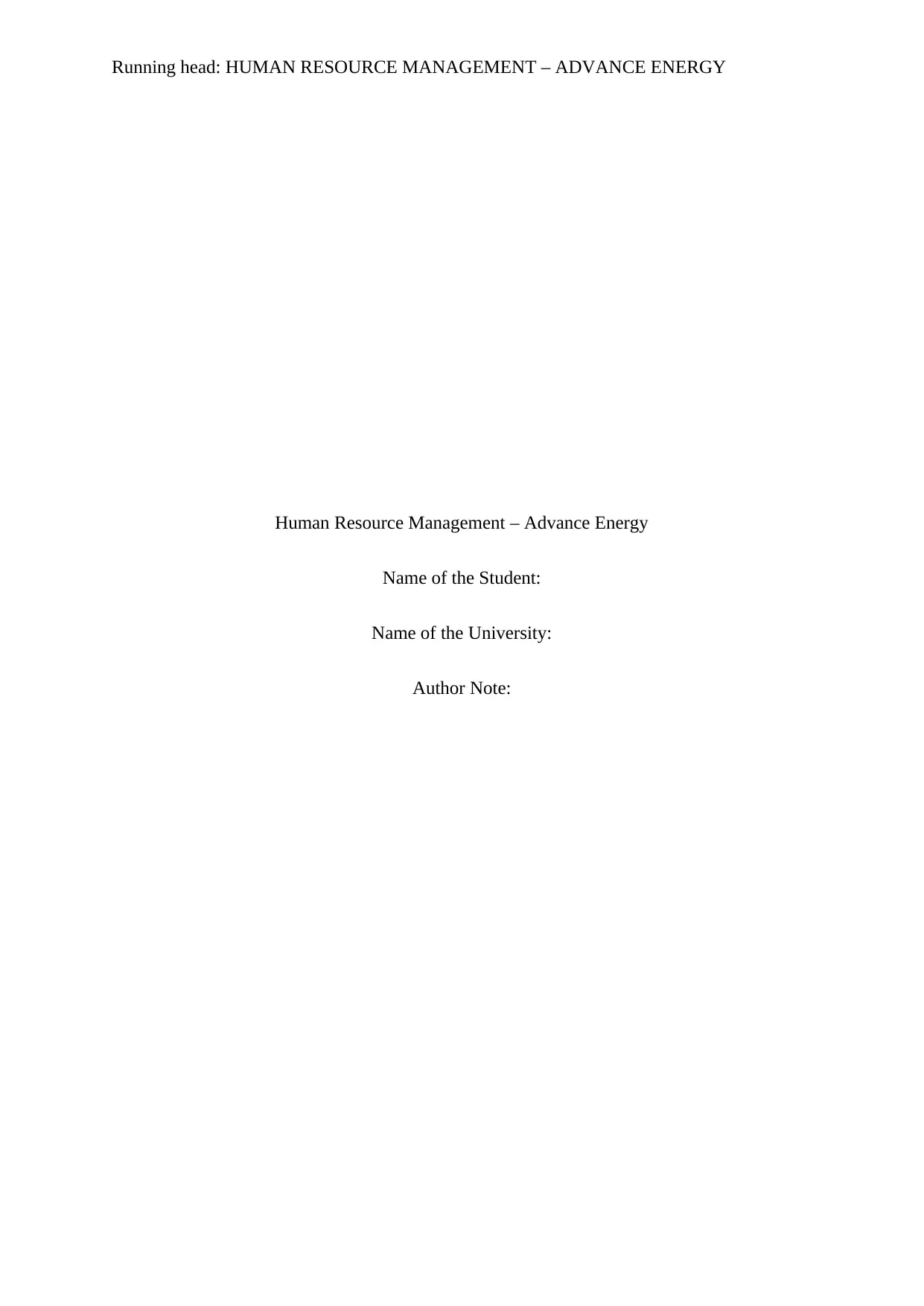
Running head: HUMAN RESOURCE MANAGEMENT – ADVANCE ENERGY
Human Resource Management – Advance Energy
Name of the Student:
Name of the University:
Author Note:
Human Resource Management – Advance Energy
Name of the Student:
Name of the University:
Author Note:
Paraphrase This Document
Need a fresh take? Get an instant paraphrase of this document with our AI Paraphraser
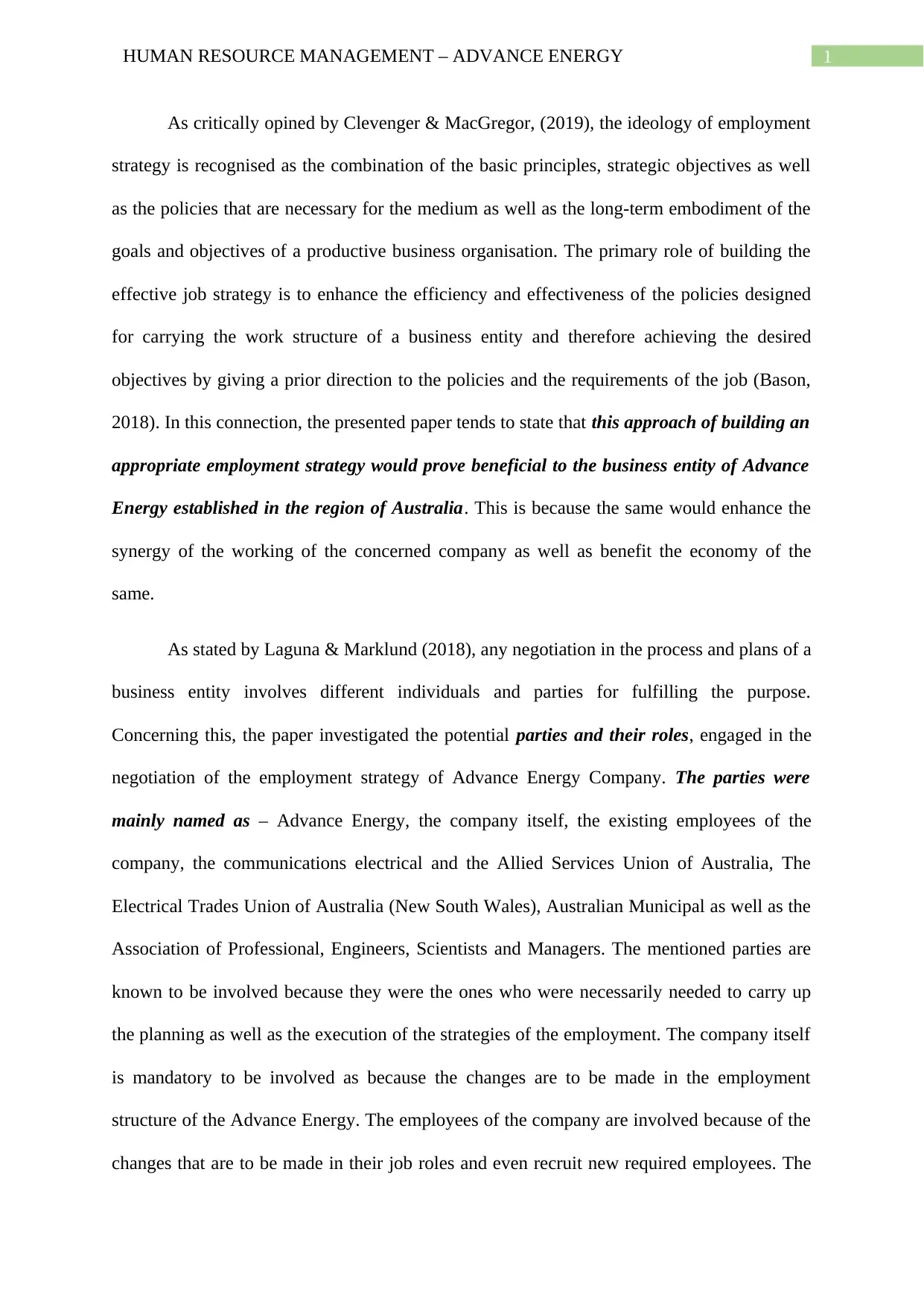
1HUMAN RESOURCE MANAGEMENT – ADVANCE ENERGY
As critically opined by Clevenger & MacGregor, (2019), the ideology of employment
strategy is recognised as the combination of the basic principles, strategic objectives as well
as the policies that are necessary for the medium as well as the long-term embodiment of the
goals and objectives of a productive business organisation. The primary role of building the
effective job strategy is to enhance the efficiency and effectiveness of the policies designed
for carrying the work structure of a business entity and therefore achieving the desired
objectives by giving a prior direction to the policies and the requirements of the job (Bason,
2018). In this connection, the presented paper tends to state that this approach of building an
appropriate employment strategy would prove beneficial to the business entity of Advance
Energy established in the region of Australia. This is because the same would enhance the
synergy of the working of the concerned company as well as benefit the economy of the
same.
As stated by Laguna & Marklund (2018), any negotiation in the process and plans of a
business entity involves different individuals and parties for fulfilling the purpose.
Concerning this, the paper investigated the potential parties and their roles, engaged in the
negotiation of the employment strategy of Advance Energy Company. The parties were
mainly named as – Advance Energy, the company itself, the existing employees of the
company, the communications electrical and the Allied Services Union of Australia, The
Electrical Trades Union of Australia (New South Wales), Australian Municipal as well as the
Association of Professional, Engineers, Scientists and Managers. The mentioned parties are
known to be involved because they were the ones who were necessarily needed to carry up
the planning as well as the execution of the strategies of the employment. The company itself
is mandatory to be involved as because the changes are to be made in the employment
structure of the Advance Energy. The employees of the company are involved because of the
changes that are to be made in their job roles and even recruit new required employees. The
As critically opined by Clevenger & MacGregor, (2019), the ideology of employment
strategy is recognised as the combination of the basic principles, strategic objectives as well
as the policies that are necessary for the medium as well as the long-term embodiment of the
goals and objectives of a productive business organisation. The primary role of building the
effective job strategy is to enhance the efficiency and effectiveness of the policies designed
for carrying the work structure of a business entity and therefore achieving the desired
objectives by giving a prior direction to the policies and the requirements of the job (Bason,
2018). In this connection, the presented paper tends to state that this approach of building an
appropriate employment strategy would prove beneficial to the business entity of Advance
Energy established in the region of Australia. This is because the same would enhance the
synergy of the working of the concerned company as well as benefit the economy of the
same.
As stated by Laguna & Marklund (2018), any negotiation in the process and plans of a
business entity involves different individuals and parties for fulfilling the purpose.
Concerning this, the paper investigated the potential parties and their roles, engaged in the
negotiation of the employment strategy of Advance Energy Company. The parties were
mainly named as – Advance Energy, the company itself, the existing employees of the
company, the communications electrical and the Allied Services Union of Australia, The
Electrical Trades Union of Australia (New South Wales), Australian Municipal as well as the
Association of Professional, Engineers, Scientists and Managers. The mentioned parties are
known to be involved because they were the ones who were necessarily needed to carry up
the planning as well as the execution of the strategies of the employment. The company itself
is mandatory to be involved as because the changes are to be made in the employment
structure of the Advance Energy. The employees of the company are involved because of the
changes that are to be made in their job roles and even recruit new required employees. The
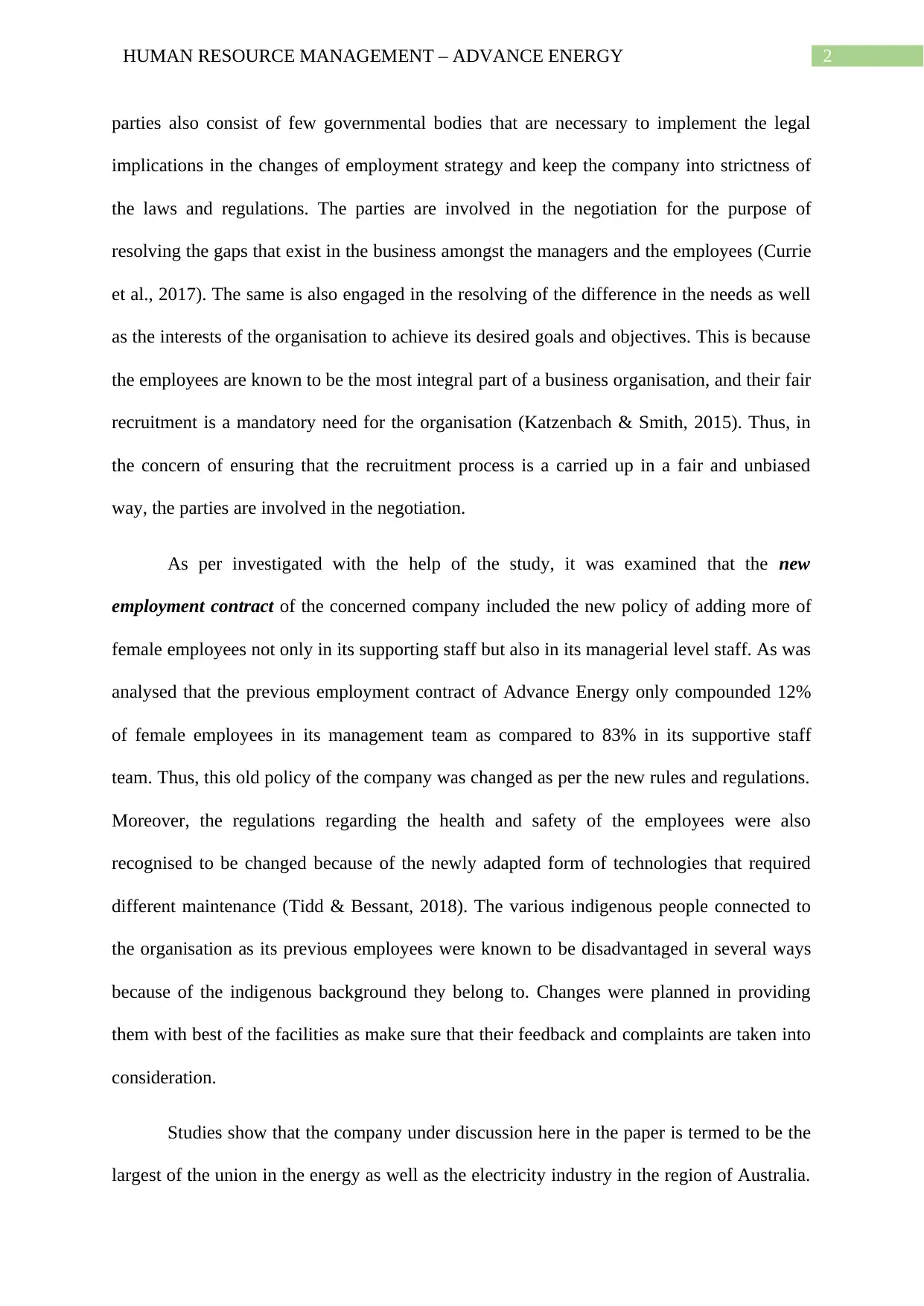
2HUMAN RESOURCE MANAGEMENT – ADVANCE ENERGY
parties also consist of few governmental bodies that are necessary to implement the legal
implications in the changes of employment strategy and keep the company into strictness of
the laws and regulations. The parties are involved in the negotiation for the purpose of
resolving the gaps that exist in the business amongst the managers and the employees (Currie
et al., 2017). The same is also engaged in the resolving of the difference in the needs as well
as the interests of the organisation to achieve its desired goals and objectives. This is because
the employees are known to be the most integral part of a business organisation, and their fair
recruitment is a mandatory need for the organisation (Katzenbach & Smith, 2015). Thus, in
the concern of ensuring that the recruitment process is a carried up in a fair and unbiased
way, the parties are involved in the negotiation.
As per investigated with the help of the study, it was examined that the new
employment contract of the concerned company included the new policy of adding more of
female employees not only in its supporting staff but also in its managerial level staff. As was
analysed that the previous employment contract of Advance Energy only compounded 12%
of female employees in its management team as compared to 83% in its supportive staff
team. Thus, this old policy of the company was changed as per the new rules and regulations.
Moreover, the regulations regarding the health and safety of the employees were also
recognised to be changed because of the newly adapted form of technologies that required
different maintenance (Tidd & Bessant, 2018). The various indigenous people connected to
the organisation as its previous employees were known to be disadvantaged in several ways
because of the indigenous background they belong to. Changes were planned in providing
them with best of the facilities as make sure that their feedback and complaints are taken into
consideration.
Studies show that the company under discussion here in the paper is termed to be the
largest of the union in the energy as well as the electricity industry in the region of Australia.
parties also consist of few governmental bodies that are necessary to implement the legal
implications in the changes of employment strategy and keep the company into strictness of
the laws and regulations. The parties are involved in the negotiation for the purpose of
resolving the gaps that exist in the business amongst the managers and the employees (Currie
et al., 2017). The same is also engaged in the resolving of the difference in the needs as well
as the interests of the organisation to achieve its desired goals and objectives. This is because
the employees are known to be the most integral part of a business organisation, and their fair
recruitment is a mandatory need for the organisation (Katzenbach & Smith, 2015). Thus, in
the concern of ensuring that the recruitment process is a carried up in a fair and unbiased
way, the parties are involved in the negotiation.
As per investigated with the help of the study, it was examined that the new
employment contract of the concerned company included the new policy of adding more of
female employees not only in its supporting staff but also in its managerial level staff. As was
analysed that the previous employment contract of Advance Energy only compounded 12%
of female employees in its management team as compared to 83% in its supportive staff
team. Thus, this old policy of the company was changed as per the new rules and regulations.
Moreover, the regulations regarding the health and safety of the employees were also
recognised to be changed because of the newly adapted form of technologies that required
different maintenance (Tidd & Bessant, 2018). The various indigenous people connected to
the organisation as its previous employees were known to be disadvantaged in several ways
because of the indigenous background they belong to. Changes were planned in providing
them with best of the facilities as make sure that their feedback and complaints are taken into
consideration.
Studies show that the company under discussion here in the paper is termed to be the
largest of the union in the energy as well as the electricity industry in the region of Australia.
⊘ This is a preview!⊘
Do you want full access?
Subscribe today to unlock all pages.

Trusted by 1+ million students worldwide
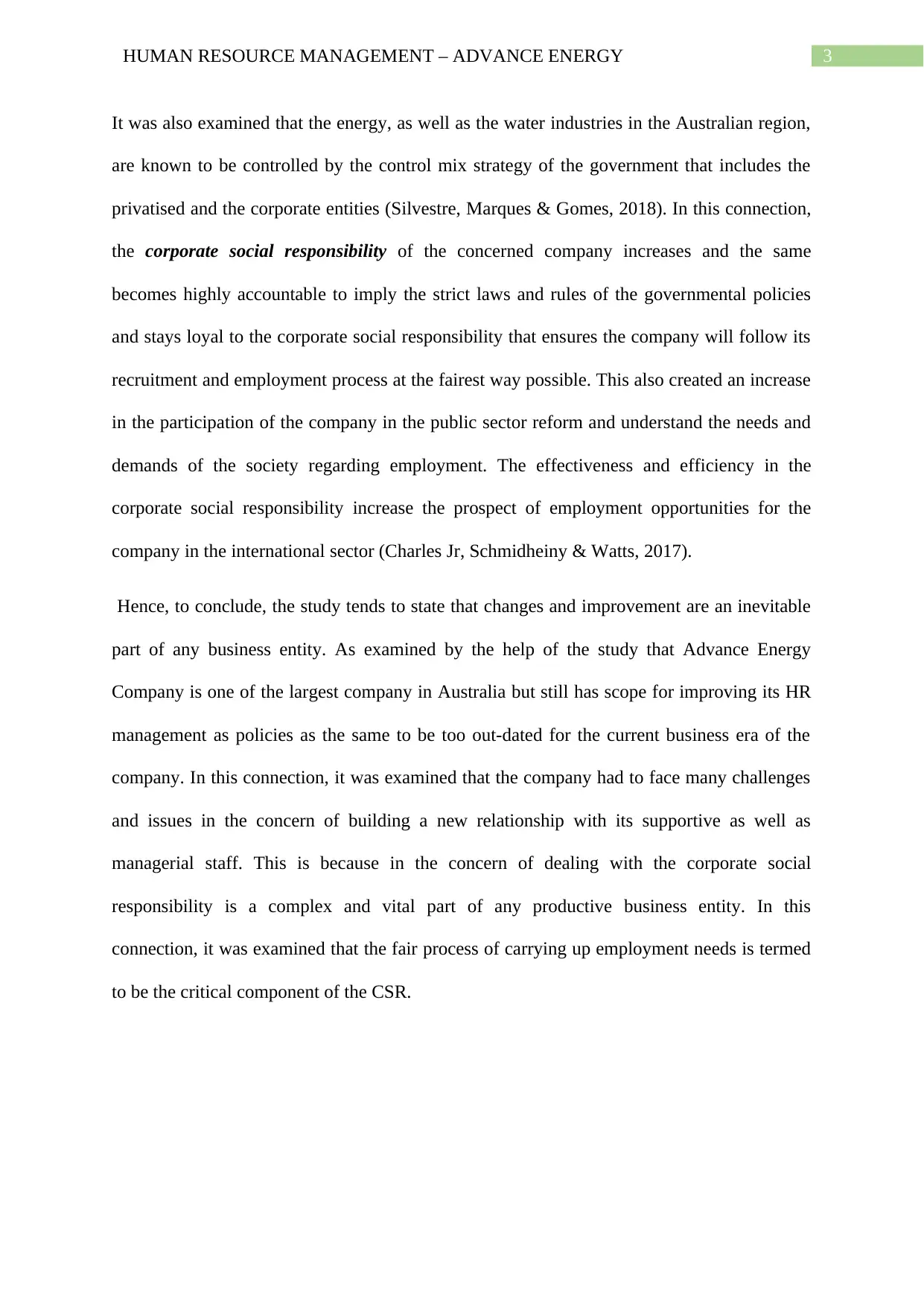
3HUMAN RESOURCE MANAGEMENT – ADVANCE ENERGY
It was also examined that the energy, as well as the water industries in the Australian region,
are known to be controlled by the control mix strategy of the government that includes the
privatised and the corporate entities (Silvestre, Marques & Gomes, 2018). In this connection,
the corporate social responsibility of the concerned company increases and the same
becomes highly accountable to imply the strict laws and rules of the governmental policies
and stays loyal to the corporate social responsibility that ensures the company will follow its
recruitment and employment process at the fairest way possible. This also created an increase
in the participation of the company in the public sector reform and understand the needs and
demands of the society regarding employment. The effectiveness and efficiency in the
corporate social responsibility increase the prospect of employment opportunities for the
company in the international sector (Charles Jr, Schmidheiny & Watts, 2017).
Hence, to conclude, the study tends to state that changes and improvement are an inevitable
part of any business entity. As examined by the help of the study that Advance Energy
Company is one of the largest company in Australia but still has scope for improving its HR
management as policies as the same to be too out-dated for the current business era of the
company. In this connection, it was examined that the company had to face many challenges
and issues in the concern of building a new relationship with its supportive as well as
managerial staff. This is because in the concern of dealing with the corporate social
responsibility is a complex and vital part of any productive business entity. In this
connection, it was examined that the fair process of carrying up employment needs is termed
to be the critical component of the CSR.
It was also examined that the energy, as well as the water industries in the Australian region,
are known to be controlled by the control mix strategy of the government that includes the
privatised and the corporate entities (Silvestre, Marques & Gomes, 2018). In this connection,
the corporate social responsibility of the concerned company increases and the same
becomes highly accountable to imply the strict laws and rules of the governmental policies
and stays loyal to the corporate social responsibility that ensures the company will follow its
recruitment and employment process at the fairest way possible. This also created an increase
in the participation of the company in the public sector reform and understand the needs and
demands of the society regarding employment. The effectiveness and efficiency in the
corporate social responsibility increase the prospect of employment opportunities for the
company in the international sector (Charles Jr, Schmidheiny & Watts, 2017).
Hence, to conclude, the study tends to state that changes and improvement are an inevitable
part of any business entity. As examined by the help of the study that Advance Energy
Company is one of the largest company in Australia but still has scope for improving its HR
management as policies as the same to be too out-dated for the current business era of the
company. In this connection, it was examined that the company had to face many challenges
and issues in the concern of building a new relationship with its supportive as well as
managerial staff. This is because in the concern of dealing with the corporate social
responsibility is a complex and vital part of any productive business entity. In this
connection, it was examined that the fair process of carrying up employment needs is termed
to be the critical component of the CSR.
Paraphrase This Document
Need a fresh take? Get an instant paraphrase of this document with our AI Paraphraser
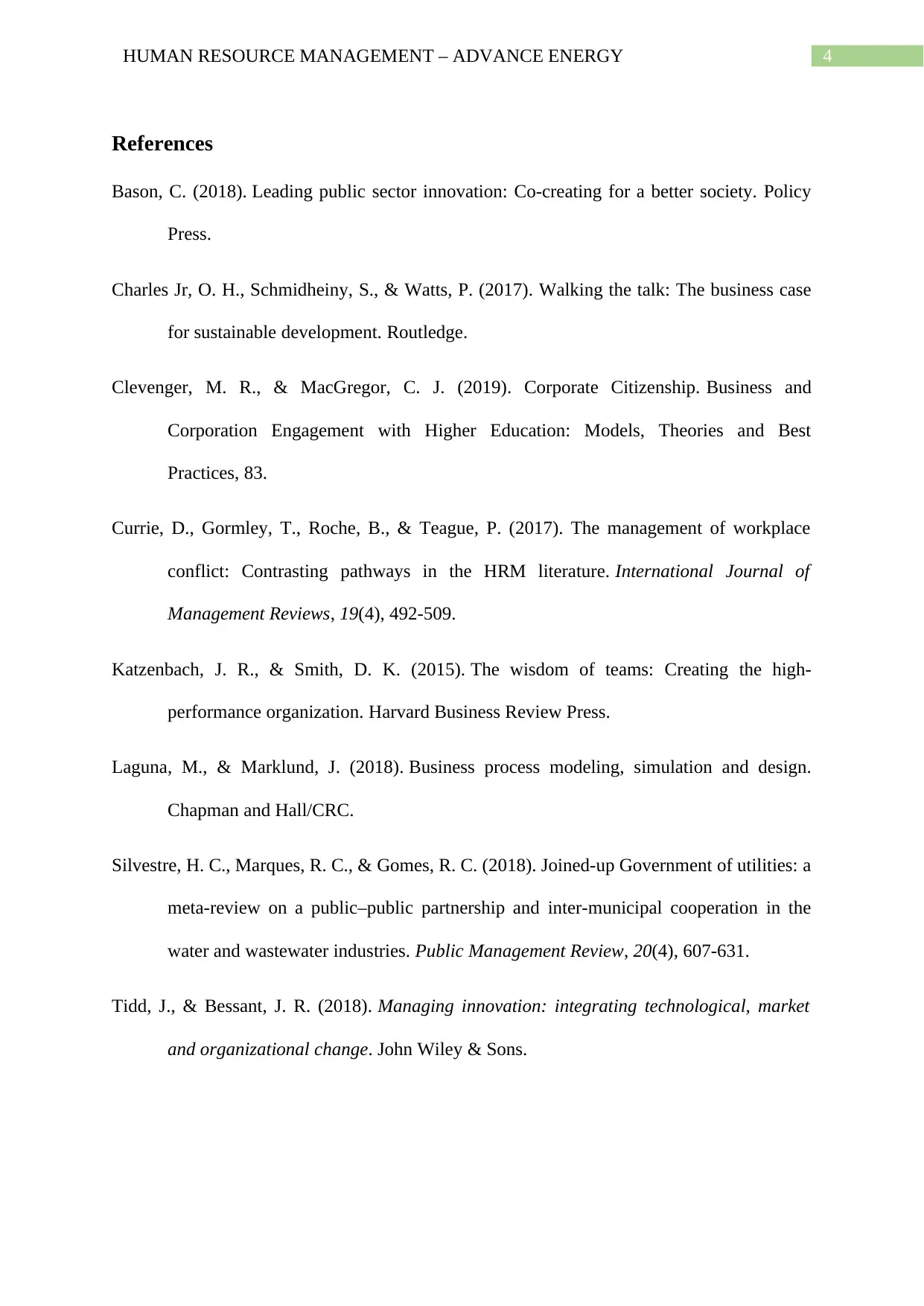
4HUMAN RESOURCE MANAGEMENT – ADVANCE ENERGY
References
Bason, C. (2018). Leading public sector innovation: Co-creating for a better society. Policy
Press.
Charles Jr, O. H., Schmidheiny, S., & Watts, P. (2017). Walking the talk: The business case
for sustainable development. Routledge.
Clevenger, M. R., & MacGregor, C. J. (2019). Corporate Citizenship. Business and
Corporation Engagement with Higher Education: Models, Theories and Best
Practices, 83.
Currie, D., Gormley, T., Roche, B., & Teague, P. (2017). The management of workplace
conflict: Contrasting pathways in the HRM literature. International Journal of
Management Reviews, 19(4), 492-509.
Katzenbach, J. R., & Smith, D. K. (2015). The wisdom of teams: Creating the high-
performance organization. Harvard Business Review Press.
Laguna, M., & Marklund, J. (2018). Business process modeling, simulation and design.
Chapman and Hall/CRC.
Silvestre, H. C., Marques, R. C., & Gomes, R. C. (2018). Joined-up Government of utilities: a
meta-review on a public–public partnership and inter-municipal cooperation in the
water and wastewater industries. Public Management Review, 20(4), 607-631.
Tidd, J., & Bessant, J. R. (2018). Managing innovation: integrating technological, market
and organizational change. John Wiley & Sons.
References
Bason, C. (2018). Leading public sector innovation: Co-creating for a better society. Policy
Press.
Charles Jr, O. H., Schmidheiny, S., & Watts, P. (2017). Walking the talk: The business case
for sustainable development. Routledge.
Clevenger, M. R., & MacGregor, C. J. (2019). Corporate Citizenship. Business and
Corporation Engagement with Higher Education: Models, Theories and Best
Practices, 83.
Currie, D., Gormley, T., Roche, B., & Teague, P. (2017). The management of workplace
conflict: Contrasting pathways in the HRM literature. International Journal of
Management Reviews, 19(4), 492-509.
Katzenbach, J. R., & Smith, D. K. (2015). The wisdom of teams: Creating the high-
performance organization. Harvard Business Review Press.
Laguna, M., & Marklund, J. (2018). Business process modeling, simulation and design.
Chapman and Hall/CRC.
Silvestre, H. C., Marques, R. C., & Gomes, R. C. (2018). Joined-up Government of utilities: a
meta-review on a public–public partnership and inter-municipal cooperation in the
water and wastewater industries. Public Management Review, 20(4), 607-631.
Tidd, J., & Bessant, J. R. (2018). Managing innovation: integrating technological, market
and organizational change. John Wiley & Sons.
1 out of 5
Related Documents
Your All-in-One AI-Powered Toolkit for Academic Success.
+13062052269
info@desklib.com
Available 24*7 on WhatsApp / Email
![[object Object]](/_next/static/media/star-bottom.7253800d.svg)
Unlock your academic potential
Copyright © 2020–2025 A2Z Services. All Rights Reserved. Developed and managed by ZUCOL.





